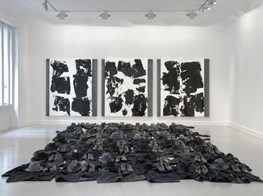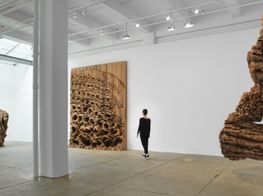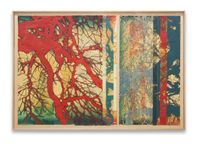Petah Coyne and Kathy Grove at Galerie Lelong, New York
In a recent group show at Galerie Lelong in New York, Narrative/Collaborative, an exhibition of photographic works generated through collaborative practices, Petah Coyne and Kathy Grove debuted their project The Real Guerrillas: The Early Years. Both American-born contemporary artists living and working in New York, Coyne and Grove witnessed the development of the elusive feminist activist group the Guerilla Girls. Known for their gorilla facemasks, witty pseudonyms and sharply humorous posters, which offer a biting criticism on the white-male hegemony of the art world, the Guerilla Girls became counter-culture icons despite their relative public anonymity.
It is the facelessness and secrecy of the Guerilla Girls that Coyne and Grove take as the focal point of their collaboration, producing portrait photographs of the members of the original Guerrilla Girls collective to document and honour each woman’s dedication to this important feminist collective. The entire project comprises two portraits of each woman who participated from 1985 through 2000. One photographic portrait depicts the selected member as her ‘alias’, masked and costumed while the second depicts the artist as herself, without a mask, in her studio surrounded by her work. As members pass away and their identities can be safely revealed, both portraits will be exhibited allowing their contributions to be fully acknowledged. The first three ‘alias’ in the series, AKA Chansonetta Stanley Emmons, AKA Lyubov Popova, and AKA Élisabeth Louise Vigée Le Brun debuted in Narrative/Collaborative keeping the identities of their true persons protected.
Ocula took the opportunity to learn more about this project from Coyne and Grove, delving into the artists’ motivation and experience working in collaboration with each other.
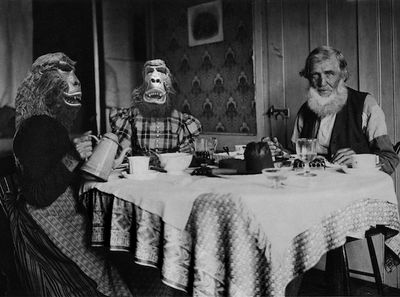
Firstly, how did your collaboration come about?
In the early 1980’s, we were both showing in the East Village where we met and became friends. A few years ago, Petah suggested we combine our skills and talents to document the Guerrilla Girls. We wanted to celebrate this influential collective that has had such an effect on the art world. A group that has endured for over 30 years, and continues to act as the gadfly and witty ‘conscience of the art world’.
What inspired the two of you to begin this on-going project The Real Guerrillas: The Early Years?
Petah and I grew up in the New York art world at the same time as the Guerrilla Girls—we saw their activities from the first posters around Soho to their most recent ventures and have always admired their moxie. The core of the Guerrilla Girls’ strength and power has always been their anonymity. We were inspired by their ingenious choice to use anonymity as a tool, to focus attention on the issues and not the personalities of the individuals. However, because of this anonymity, the historical record cannot fully acknowledge each member’s contribution. This project was conceived to document and become a testament to the collective efforts of the Guerrilla Girls. The earliest members were instrumental in paving this pathway for the future of the collective.
We were also inspired by their decision to use historically under-recognised women artists as their alias personas. In doing so, they acknowledged the achievements of their predecessors. We were often surprised to find that each member’s chosen alias was somehow akin to their own personal history. You will see this relationship in the intuitive text that accompanies each portrait.
In what ways, if at all, do you feel this project relates to, informs and expands upon both of your solo practices?
This project has already taken nearly three years to debut just the initial four alias portraits, and will take an additional few more to fully complete. It will undoubtedly have a lasting impact on both of our practices. You should ask again once the project is complete.
What are the benefits and challenges of working collaboratively?
Working collaboratively can be challenging but also has many advantages. It forces one to acknowledge another point of view, expand your skills and listen closely. While we have complimentary skill sets, working together gives us a little peek into a unique way of thinking. There are certainly bumps along the way, but in the end we arrive at something that neither of us could have created alone. Something much stronger! That was our hope from the beginning!

Have any of the contemporary Guerrilla Girls (post year 2000) been involved in the project?
Yes. A few Guerrilla Girls have worked without interruption from 1985 until today. Their alias images have not been released but will be soon.
The Guerrilla Girls remain very active today—why did you choose to focus on the early years?
During the 1980’s the New York ‘art world’ was centralised in a few blocks within Soho. It was relatively small and closed compared with the interconnected 24-7-365 global art world that exists today. The immediate impact that the Guerrilla Girls had was nothing short of astounding: using humor, statistics, anonymity, and a few advertising tools. The Guerrilla Girls have undergone many transformations. The formulative early years were crucial towards the long time survival of the group. During this time, the core methodology was collectively developed. Petah and I feel it is critical to preserve this early history and acknowledge all the people who participated and made it all happen.
In addition to the portraits, we are also conducting audio interviews with each of the members who were active between 1985 and 2000. This has unintentionally produced a unique timeline, portraying the successes and failures, the triumphs and growing pains, the laughter and the tears, through the anecdotes and memories that are particular to each member and the group as a whole.
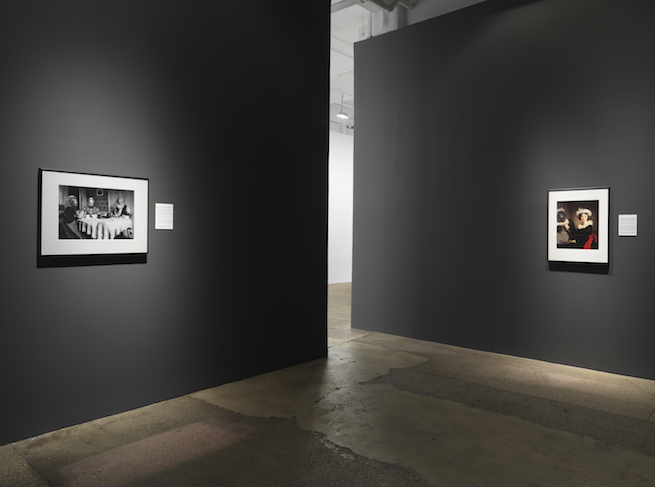
As a group, Guerrilla Girls are founded on their anonymity—what motivated you to expose them upon their death?
Anonymity was a tool successfully employed by the collective to focus solely on the issues and to expose the flagrant discrimination that continues to be encountered by women in the art world. We feel these individual women deserve to be acknowledged for their heroic efforts in accepting the condition of anonymity. The Guerrilla Girls understood that they would never receive individual credit for their personal contributions while they were alive. Such selfless action deserves some recognition, if only after death. Just as the Guerrilla Girls chose to honour their predecessors with each chosen alias, we hope to equally celebrate and recognise the contributions of each early member.

The Guerrilla Girls target contemporary art galleries for their hierarchy, money and focus on white, male artists. How do you think the Guerrilla Girls in the works on display would feel about having their portraits hung in a gallery or institutional environment?
They would love it! All they ever wanted was an equal playing field. —[O]

